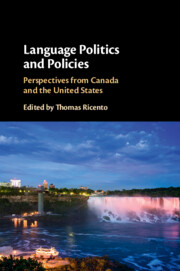Book contents
- Language Politics and Policies
- Language Politics and Policies
- Copyright page
- Dedication
- Contents
- Figures
- Tables
- Contributors
- Preface
- Contributor Personal Statements
- Introduction
- Part I Theoretical Orientations
- Part II The United States Context
- 5 Disciplining Bilingual Education
- 6 Measured Multilingualism
- 7 The Rise, Fall, and Rebirth of Bilingual Education in California and the Ongoing American Dilemma
- 8 Language Policy Conflicts
- 9 Indigenous Language Movements in a Settler State
- 10 The Politics of Language Education Policy Development and Implementation
- Part III The Canadian Context
- Index
- References
6 - Measured Multilingualism
Census Language Questions in Canada and the United States
from Part II - The United States Context
Published online by Cambridge University Press: 18 July 2019
- Language Politics and Policies
- Language Politics and Policies
- Copyright page
- Dedication
- Contents
- Figures
- Tables
- Contributors
- Preface
- Contributor Personal Statements
- Introduction
- Part I Theoretical Orientations
- Part II The United States Context
- 5 Disciplining Bilingual Education
- 6 Measured Multilingualism
- 7 The Rise, Fall, and Rebirth of Bilingual Education in California and the Ongoing American Dilemma
- 8 Language Policy Conflicts
- 9 Indigenous Language Movements in a Settler State
- 10 The Politics of Language Education Policy Development and Implementation
- Part III The Canadian Context
- Index
- References
Summary
Since their widespread adoption in the nineteenth century, censuses have played both bureaucratic and ideological roles, as the classification of the population according to social and cultural characteristics facilitated the development of the administrative infrastructure required by emergent nation-states and the definition of national and group identity categories officialized particular ways of understanding difference. This chapter critically analyzes the questions about language asked by Statistics Canada and the US Census Bureau. I examine the relationship of language data to various policies in the two countries, as well as the ways that those policies, and specific ways of asking about language, reflect and reproduce particular ideologies of language. In addition to revealing differing perspectives on individual and societal multilingualism, this analysis demonstrates that census language statistics do not simply serve as "facts" undergirding policy, but instead produce particular representations of linguistic diversity and, thus, constitute official discourses on multilingualism.
Keywords
- Type
- Chapter
- Information
- Language Politics and PoliciesPerspectives from Canada and the United States, pp. 114 - 134Publisher: Cambridge University PressPrint publication year: 2019
References
- 1
- Cited by

